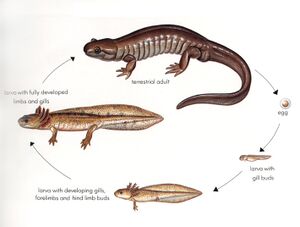Salamanders

Description
Salamanders are a group of amphibians in the order Caudata [1], with over 740 species of salamander in 10 families, with the largest family being Cryptobranchidae [1]. Salamanders are characterized as amphibians which have tails as adults, which stores fats and proteins and assists with movement [1]. Salamanders are typically small animals, usually reaching no more than 4 to 6 inches when fully grown [1]. There are notable exceptions however, with some species, reaching much larger sizes. Most notably, the Japanese giant salamander can reach up to 5.6 feet in length [1]. Other well known examples of salamanders include axolotls, hellbenders, sirens, and newts [1]. Salamanders can be found in temperate and tropical climates worldwide, with most of their diversity occurring in temperate regions of the northern hemisphere [1].
Habitat and Range
Salamanders can be found throughout almost the entire northern hemisphere with the one exception being the Amazon basin in South America [3]. The greatest amount of salamander diversity can be found in the United states, with all but one of the families being found there, the Hynobiidae or Asiatic salamanders [2]. All species of salamanders require access to a nearby water source, as it is essential for them to keep their skin moist in order to survive [2]. Some groups, particularly newts, spend most of their time out of the water while others, such as hellbenders, are almost fully aquatic [2]. Some other species are cave specialists and spend most, if not all of their lives in total darkness [4].
Life Cycle

Salamanders are amphibians and like most amphibians they reproduce by laying eggs. In most species, reproduction is done via internal fertilization although a few species use external fertilization [3]. After fertilization, eggs are typically laid in clusters in shallow water. Some species however, lay eggs in moist terrestrial locations, such as under logs or on leaves [3]. Once the eggs are laid, it is common for the female to stay with them until they hatch [3]. Most salamander species begin their lives as a fully aquatic larva which then undergoes a metamorphosis before transitioning to a more terrestrial adult [3]. Not all species do this though. A number of species never fully metamorphize and the adults retain several juvenile features, a process called paedomorphosis [3]. The most well known species to undergo paedomorphosis is the Axolotl [3].
Diet
All species of salamanders are carnivores with insects being the most common prey item [3]. Diet does vary widely across species, mostly depending on the size of a particular species. Small salamanders eat mostly insects and other small invertebrates while some of the largest species have diets that include larger prey items, including fish, crustaceans, and small mammals [4]. Salamanders are mostly slow moving animals and this limits their ability to catch fast prey items [4]. This limitation is partially made up for in some, mostly tropical, species which have specialized tongues which can be rapidly protruded from the mouths to grab prey items [3].
References
[1] salamander | Species, lifestyle, & facts. (n.d.).. https://www.britannica.com/animal/salamander
[2] Facts About Salamanders | Live Science. 2015, October 29.. https://www.livescience.com/52627-salamanders.html
[3] Caudata | Characteristics & Facts | Britannica. (n.d.).. https://www.britannica.com/animal/Caudata
[4] Salamander and Newt | San Diego Zoo Animals & Plants. (n.d.).. https://animals.sandiegozoo.org/animals/salamander-and-newt#:~:text=HABITAT%20AND%20DIET,dug%20in%20the%20damp%20earth.